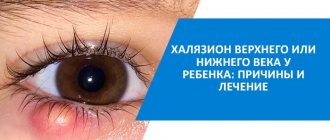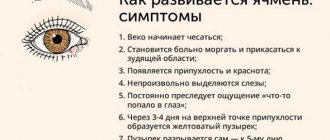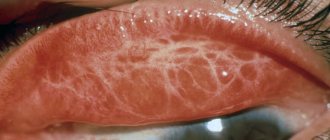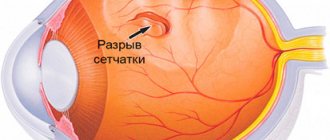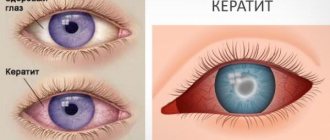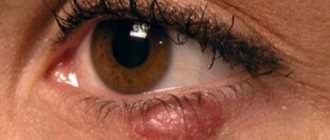People who have had a swelling or bump on their eye at least once in their life confidently think that it is a stye. But not many people know that this disease can have a different name and have a different nature of occurrence. Let's try to understand two different diseases in which the first symptoms are similar.
The most correct option if any deviation from the norm occurs in the body is to consult a doctor. However, there is not always such an opportunity and time. Therefore, minimal medical literacy will help you make an adequate assessment of the situation.
Share
Tweet
Share
Cool
Send
What is a chalazion?
Chalazion is a condition that develops due to blockage of the meibomian glands (modified sebaceous glands that open near the outer edge of the eyelids). It has the appearance of a dense benign neoplasm with clear contours and a round shape. As a result of the blockage of the duct, the secretion accumulates and a small round tumor grows.
Useful video
Chalazion treatment:
How is eye pressure measured?
At home, the patient can use only one method available to him - palpating the eyeball through the eyelids, determining by touch the degree of its density. If the pressure is normal, then with gentle pressure you should feel a moderately elastic round ball under your fingers. With an increased IOP, it will be quite hard and not prone to deformation, but with a decreased IOP, on the contrary, it will sag. Of course, this method does not give correct readings and can only be used to understand the approximate condition, although people suffering from elevated IOP acquire the necessary skills over time. The exact data can be found in the doctor’s office, where he will conduct an examination using special instruments and also examine your fundus.
Tonometric measurement method. This is done using a tonometer. There are several types of them, but the most famous and common are Maklakov tonometer and Goldman tonometer
We will not go into technical details and a description of the measurement procedure, the only important thing is that these methods will help determine the exact intraocular pressure. Non-contact tonometers. Sophisticated electronic devices that are increasingly used today, as this method gives even more accurate readings
If, with the help of the first two tonometers, a direct effect is made on the eye, drugs are used to anesthetize the cornea, since there is a physical effect on the organ of vision, then with the help of a non-contact tonometer, measurements are carried out using a stream of air directed at the cornea.
Causes of diseases
Basically, barley is formed due to the penetration of pathogenic pathogens into the sebaceous gland. These include Staphylococcus aureus and Streptococcus. In normal life, these bacteria are always found on the skin of a healthy person in minimal quantities. But if, for example, you have a weakened immune system or hypothermia occurs, then they begin to multiply and spread to healthy skin, which can lead to barley and more. There are also some diseases in which hordeolum can appear again and again.
These are diabetes mellitus, chronic gastrointestinal diseases, problems with the endocrine system, vitamin deficiency, demodicosis, allergies, including the eyes, infection from other purulent foci with lymph or blood.
The causes of a neoplasm called chalazion are similar to stye. This includes hypothermia, colds, gastrointestinal diseases, failure to comply with the rules of personal hygiene, injury to the organs of vision, foreign body getting into the eye, etc. It can also form from stye on the eyelid if a person has suffered severe stress or has a hormonal and sugar background.
Categories of citizens who do not pay tax
Each subject of the Russian Federation has its own benefits for the collection of transport tax. In most regions of the Russian Federation, the following citizens are exempt from transport tax:
- Veterans and disabled people of the Great Patriotic War, including labor veterans, prisoners of various forced confinement (concentration camps, ghettos) created by the Nazis and their allies during the Second World War.
- Heroes of the USSR or the Russian Federation and citizens who have received awards of the Order of Glory of any degree.
- Persons with a veteran's certificate and war veterans who became disabled during hostilities;
- Persons classified as disabled people of groups 1 and 2;
- Pensioners (women over 55 years old, men over 60 years old) receiving a pension from the state. Pensioners who have earned work experience in the Far North can claim benefits at the following ages:
- for women – 50 years;
- for men – 55.
- Participants in the liquidation of the consequences of the man-made disaster at the Chernobyl nuclear power plant, who have social benefits due to receiving a radiation dose.
- Participants in testing nuclear and thermonuclear weapons, as well as accident liquidators at the country’s military facilities;
- One of the parents (guardians) in a family with large families;
- One of the parents (guardians) who has a dependent child with a disability.
- Owners of a car with an engine power of less than 70 horsepower;
- Citizens whose car is considered stolen.
Conditions for benefits:
- Exemption from payment of vehicle tax is provided to preferential categories of citizens if the vehicle in their possession has a power of less than one hundred horsepower. If the established norm is exceeded, the tax is calculated on the difference in capacity.
- The benefit applies to only one vehicle.
- If a citizen belonging to preferential categories owns more than one number of vehicles, in this case the tax is set in full on one of them.
Differences in symptoms
| Onset of the disease | height | Final stage | |
| Barley | Onset of the disease: pain, redness and swelling of the eyelid, watery eyes and/or foreign body sensation. | An abscess forms at the top of the swelling and is yellow in color. If it is external, then it is close to the edge of the eyelid, and if it is internal, it is on the inner surface of the eyelid. | The abscess breaks out with the release of pus. |
| Chalazion | Moderate swelling, no inflammation, a pea-sized formation can be felt under the skin. | Enlargement of the lump, feels like a moving dense pea, swelling, swelling, discomfort, increased sensitivity. | Spontaneous resorption (rare), leaving a thickening. |
What pressure values indicate the presence of pathology?
In a situation where IOP has elevated values, this is a sign to sound the alarm, since its increase indicates the presence of glaucoma at different stages. Here is a table from which you can find out how dangerous you are from this disease 1. A value from 10 to 22 mm Hg is considered normal. Art. (usually 15-17). 2. A pressure of 22 to 25 mmHg may indicate primary signs of glaucoma, in which case a thorough examination should be performed. 3. The figure 25-27 mmHg most likely confirms the presence of the initial stage of glaucoma. 4. When the ophthalmotonus level is 27-30 units, we can say that glaucoma is actively developing. 5. IOP value is above 30 mm Hg. Art. means a severe degree of development of the disease.
We remind you that the change in pressure inside the eyes during the day should not exceed the norm of 3-4 mm Hg. Art. - higher in the morning, lower in the evening. What factors may prompt you to contact a specialist to check your eye pressure?
Complications
Damage to the top layer of skin of the stye or self-squeezing promotes the spread of infection in the body. This may be the cause of inflammation of the orbital (orbital) tissue - orbital phlegmon. If hordeolum is not treated with anything, the patient’s vision sharply decreases, and the eyeball becomes inactive.
Another consequence is thrombophlebitis of the orbital veins (an acute inflammatory process in the veins of the orbit, caused mainly by coccal flora penetrating through the veins into the orbit from purulent inflammatory foci of the eyelids, lacrimal sac area, facial skin, oral cavity, paranasal sinuses). All these diseases have very serious consequences for the human body, including purulent meningitis.
A complication of chalazion is the addition of a secondary infection, which threatens an abscess. Or, for example, a fistula (a canal connecting the skin and the capsule) may form. It is important to understand that such a “bump” on the eyelid can put constant pressure on the eyeball and provoke conjunctivitis in the patient.
Useful video
The nature of stye on the eye and how to treat it:
Are blepharitis and stye the same thing?
The causes and symptoms of stye formation are very similar to the signs and factors for the development of blepharitis. Because of this, many people believe that these are the same disease. Blepharitis is a bilateral inflammation of the ciliary margin of the eyelids, which can recur. Its occurrence may be preceded by various reasons, so doctors distinguish several forms of this pathology, namely:
- acne;
- seborrheic;
- allergic;
- demodicosis;
- ulcerative
In ophthalmology, the term "blepharitis" is often used to refer to a large group of inflammatory diseases. All of them form on the eyelids and often reappear after treatment. The most common conditions that ophthalmologists can characterize as blepharitis are: stye, meibomitis, chalazion. These pathologies sometimes develop in turn. In the absence of proper treatment, one inflammatory process flows into another. The "internal form" of the hordeolum is a meibomite. The condition is associated with inflammation of the meibomian glands. There is also a meibomian type of blepharitis, which is similar in symptoms and course to the “internal form” of stye. One of the signs of hordeolum is thickening of the edges of the eyelids and the formation of dry scales at the site of inflammation. Barley, which is characterized by this symptom, resembles seborrhea of the eyelids - scaly blepharitis.
Prevention
Preventive methods are aimed at preventing the occurrence of the disease or its relapse. To do this, you should stick to basic things:
- Get rid of chronic infectious processes in the body. For example, tonsillitis and caries.
- Observe hygiene standards, wash your hands thoroughly.
- Limit consumption of foods containing artificial colors, sugars and flavor enhancers.
- Maintain a sleep schedule. It is best to use pillows with padding polyester or other hypoallergenic filling, since chicken and goose down can provoke diseases.
- Avoid constant stress and avoid overwork.
- As recommended by your doctor, take regular courses of vitamins and microelements.
- As a preventive measure, massage the eyelids. This improves blood flow, metabolic processes and prevents clogging of the gland.
- At least once a month, use the drug “Artificial tear” prophylactically. This drug will relieve swelling and fatigue of the eye and help in the formation of a protective film.
- Whenever possible, use natural absorbents for external use, such as used tea bags. Tea contains the substance tannin, which is a natural external absorbent. Such eye compresses will remove dangerous substances from the mucous membrane and reduce the possibility of developing diseases.
Prevention is easier than cure.
Treatment
If the levels are elevated, a diagnosis of congenital glaucoma is made at an early age. In this case, conservative treatment is used as a concomitant method in preparing the baby for surgery. Depending on age, the following is carried out:
- homeopuncture;
- trabeculotomy;
- sinustrabeculectomy;
- install drainage systems.
It is recommended to use biological supplements to obtain a sufficient amount of vitamins - Okuwait Lutein, Blueberry Forte, Superoptic.
For low levels, treatment is as follows:
- Medicines with an antibacterial effect are prescribed if uveitis or iritis is detected.
- Prescribed drugs that help strengthen the walls of blood vessels. This will prevent their ruptures and redness of the mucous membrane.
Also, for eye hypotension, it is recommended to use vitamin complexes and medications with ATP.
Surgical treatment is suggested as a last resort. Most often, the operation is performed when the visual organ is fully formed. For schoolchildren and children, surgical intervention is indicated only in emergency situations, when vision cannot be saved by conservative methods and IOP continues to decrease.
Prevention is based on proper nutrition, frequent walks, timely treatment of any eye diseases and annual preventive examinations.
